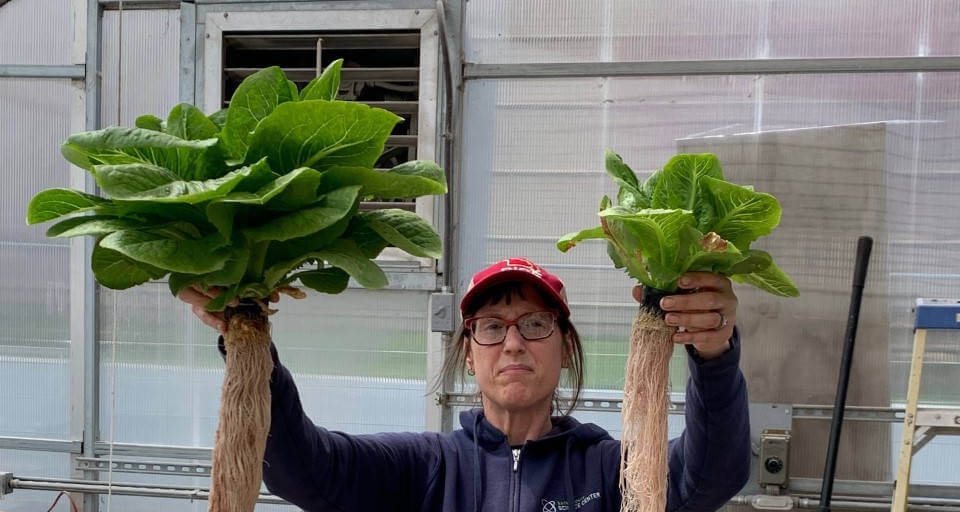 Hello again everyone! For those of you who don’t know me, my name is Chris, and I’m a new part-time facilitator at GROW this summer. Some of you might remember me from last year’s greenhouse blog posts, where I talked about everything from aphids, to fish, to commercial lettuce. Being a YES Teen with the Science Center was so much fun that I decided to come back as a full-blown employee (oh how times change).
Hello again everyone! For those of you who don’t know me, my name is Chris, and I’m a new part-time facilitator at GROW this summer. Some of you might remember me from last year’s greenhouse blog posts, where I talked about everything from aphids, to fish, to commercial lettuce. Being a YES Teen with the Science Center was so much fun that I decided to come back as a full-blown employee (oh how times change).
Anyway, it’s been a whole year since I’ve been at GROW, so for this blogpost we’ll take a dive into what’s been going on in the greenhouse and what discoveries the team has made over the past year.
The GROW team had a very standard growing method for our hydroponic plants. We start our seeds in regular soil and let them grow into the seedling state. Once they’re big enough, we take the plant out of the pot, wash off the soil, and transfer the plant to a hydroponic basket with pebbles as the new growing medium. The system has worked tremendously well for us, but a wise person once said, “there is no innovation without experimentation,” so the team decided to try out a new method: growing plants in peat moss.
Peat moss is made from a genus of mosses referred to as Sphagnum. These mosses are renowned for the ability to retain large amounts of water in their cells. As such, these mosses are harvested and dried to serve as a growing medium. In a hydroponic setting, compressed peat moss pellets are often used as an all-stage growing medium. In other words, a plant can be grown from seed to adult without ever having to repot or transfer. Not only would this be a time and effort saver for us, it would also help avoid the phenomenon of transplant shock. When we transfer plants from soil to hydroponic with our typical method, the sudden change in environment can be harsh on the plants. Starting from peat moss could help in resolving this issue. This method is popular amongst conventional gardeners and hydroponic enthusiasts alike, and is, in fact, the method our friends at VAST Produce use to grow their lettuce. They drop their seeds into a peat moss pellet, and once the seed has grown into a seedling, they transfer the plant (peat moss and all) into a hydroponic raft.
What the team found, however, was that the lettuce grown in peat moss was comparably smaller than the lettuce grown in soil. Of course, size varied from plant to plant, but in many instances the soil-grown lettuce outsized the peat moss-grown lettuce in both root density and leaf size. Pictured below is Hannah, the Plant and Animal Manager at GROW, showcasing one of the more extreme size differences. Without knowing the difference in growing medium, you would almost think that the two lettuce plants were in completely different stages of growth.
It’s clear that the lettuce grown in the conventional method fared much better, but why was that? We don’t have a concrete answer, but we have some theories. The density of peat moss could be one influencing factor. Compressed peat moss pellets are soft but are more springy than malleable; this could make it harder for the plant roots to pierce and grow through the moss. Combine this with the fact that the roots must also grow around the hard, plastic basket walls of a peat-moss container, and we have a situation where root growth is inhibited to the point where the main plant suffers.
Furthermore, even if the peat moss method is sound, we want to consider the environmental impact of commercial peat moss. Sphagnum mosses are harvested from bog marshes that only account for 2% of the land worldwide. This combined with the fact that it takes about 15-25 years for just an inch of peat moss to develop raises questions about the sustainability of commercial peat moss. Additionally, there are many concerns about the fact that bogs and swamps contain one third of the world’s carbon. By harvesting peat moss, we are essentially releasing that carbon (in the form of the infamous carbon dioxide gas) into the atmosphere.
The peat moss method certainly has promise and is backed by several years of industry success, but it’s pros and cons need to be weighed carefully before we fully commit to adopting this new method. As we move into the future, we’ll continue to work with both soil and peat moss, studying the effects of each and discussing about how we can continue to improve our practices here at GROW.
See what else is happening in GROW!






